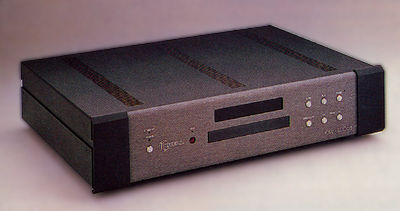| Columns Retired Columns & Blogs |
Krell KAV-300cd CD player
You'd be hard-pressed to find a company more protective of its reputation than Krell. At a recent meeting of the Academy for the Advancement for High End Audio and Video, a motion was made to replace the phrase "High End" with the more purely descriptive "High Performance." Krell's CEO, Dan D'Agostino, objected—while he knew the description fit his products, he wasn't sure about those from some of the other members.
Footnote 1: See Stereophile, July 1996, Vol.19 No.7.—Wes Phillips

So when Krell announced its KAV line of products, designed to offer components that conform to Krell's design philosophy and build standards but intended to sell at far lower prices than its premier line, some people were startled. Wouldn't this move, by definition, blunt some of Krell's reputation for living on the cutting edge?
Krell's answer was the KAV-300i integrated amplifier—a product that has won critical acclaim (footnote 1) and immense sales worldwide. Now they've diversified the line by introducing a pair of monoblock power amps, a preamplifier, and the KAV-300cd compact disc player, the subject of this review. I'll let others weigh in on the amp and preamp, but the KAV-300cd is pure Krell.
Surely you didn't think Dan D'Agostino would let it be anything else?
Nothing is more simple than greatness...
The KAV-300cd has the subdued metalwork that distinguishes all Krell products. The fascia is brushed gray aluminum with broad, black bands standing out at each end. The drawer and the display are smack dab in the middle. Other than that, a scant seven silver buttons offer rudimentary control over the unit: Standby sits alone on the far left, while two rows of buttons on the right command Track Forward and Back, Play, Pause, Stop, and Drawer Open/Close. The remote expands on these options with other functions—including Display Off—as well as offering simple commands to other Krell components such as pre- and power amplifiers.
Rear-panel accommodations include switchable digital out (TosLink or S/PDIF RCA), an IEC mains jack, an easily accessible fuse holder, two sets of analog outs (RCA and balanced XLR, pin 2 noninverting), 12V remote trigger, and an RC-5 remote control input.
...indeed, to be simple is to be great
But don't be fooled by the simplicity—the 300cd is packed with ultra-high-quality parts and really slick technology. Take its centrally located drawer: Housed within the chassis is TEAC's CMK-4 transport mechanism, which features its own suspension system as well as TEAC's Vibration-Free Rigid Disc-Clamping System (VRDS). The VRDS mechanism uses a CD-sized cast aluminum overhead turntable to support and stabilize the whole disc. This "platter" is slightly concave; when the disc is pressed into it from below, it couples firmly to it. This, TEAC claims, helps control unwanted vibrations and warps. (The laser, by the way, adjusts its angle throughout play to compensate for the disc's concavity.) The transport's molded parts are made from phenolic oxide, which Krell describes as "a special high-molecular material" designed to eliminate mechanical and acoustical disturbances.
The heart of the digital side of the KAV-300cd is Krell's high-stability, low-jitter master clock, which controls the transport electronics and digital circuitry. The datastream controlled by it flows into the Pacific Microsonics digital filter/HDCD decoder, which outputs 20-bit data to each channel's Burr-Brown PCM1702K 8x-oversampling DACs (footnote 2). The signal is fully balanced right out of the DAC: There are four independent pathways—inverting and noninverting for left and right channels. All circuitry is discrete and complementary.
The analog circuitry uses Krell's Current Mode Gain amplification. According to Krell's North American Sales Manager, Bill McKiegan, this circuitry uses "about a bazillion" discrete bipolar transistors (footnote 3): "We use the same Current Mode Gain circuitry for the output circuitry on the KAV-300cd that we use on the KRC-3 and the Full Power Balanced amplifiers. It drives the signal as current rather than as voltage, which makes for faster delivery and quicker, more linear topology than in voltage-gain stages. This requires a ton of parts, which is why you don't see it much in audio—but Dan [D'Agostino] has never been afraid of putting parts in a box if it was the right thing to do," he explained.
All analog circuitry runs in class-A and is direct-coupled. Krell's philosophy dictates that this ensures low distortion and exceptionally wide bandwidth.
Footnote 1: See Stereophile, July 1996, Vol.19 No.7.—Wes Phillips
Footnote 2: The "K" designates a specially selected version of the 1702, which is already a pretty slick chip: fast (settling current is 200ns), quiet (120dB S/NR, rated type A), and clean (-96dB THD). Advanced sign-magnitude architecture is claimed to eliminate unwanted glitches and other nonlinearities around bipolar zero, according to Burr-Brown.—Wes Phillips
Footnote 3: Martin Colloms told me he'd totted up nearly 300 of them before losing count.—Wes Phillips
- Log in or register to post comments



































